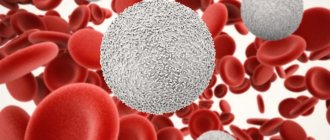Why take a general blood test?
A general blood test is one of the most common diagnostic procedures. It is carried out to identify pathological processes - they always affect the composition of the blood, even if they are asymptomatic. In order to make a correct diagnosis, the doctor sends you for a general analysis. It is also carried out during a routine medical examination, before vaccination and several times during pregnancy. In addition, a general blood test helps to understand whether the medications the patient is taking are working and to prescribe new ones.
Which population groups are subject to research?
It is recommended for people who are at risk to take a coronavirus test in the presence or absence of symptoms:
- • citizens who are in close contact with people infected with COVID-19;
- • hospitalized patients diagnosed with community-acquired pneumonia;
- • people aged 65 years and older with symptoms of ARVI;
- • employees of healthcare organizations, educational institutions, etc.;
- • social workers and nursing home workers;
- • residents of areas where there is a concentration of clusters (guest workers);
- • healthcare workers who do not have symptoms;
- • workers of essential professions in contact with the population.
It is recommended that all citizens with ARVI symptoms be tested for coronavirus. Employers are required to test 10% of employees every 2 weeks.
How it's made
First, blood is taken from a vein, or less often from a finger, then the samples are sent to the laboratory. This is a simple procedure, you don’t need to prepare specially for it - but doctors usually recommend coming to donate blood on an empty stomach so that the results are not affected by the patient’s diet. It is also better to drink water before the analysis, rather than tea or coffee - they trigger many biochemical reactions, which can add chaos to the test results. If the test needs to be taken several times over a period of time, it is better to carry it out at the same time in the same state, for example, always at 8 am on an empty stomach.
When is it necessary to do a test?
The most common signs of COVID-2019:
- • increased body temperature;
- • dry cough or cough with little sputum;
- • myalgia and excessive fatigue;
- • feeling of tightness in the chest area;
- • hemoptysis (in 10% of cases);
- • loss of appetite;
- • muscle pain;
- • shortness of breath and difficulty breathing;
- • confusion;
- • loss of taste and smell (anosmia);
- • sore throat and runny nose;
- • skin rash;
- • change in skin color of the toes and hands.
What can you learn from it?
From the results you can learn about several indicators of blood composition: hemoglobin, red blood cells, hematocrit, platelets, leukocytes, erythrocyte sedimentation rate and others.
Red blood cells. Erythrocytes or red blood cells are the most common cells in the human body. They contain hemoglobin and together with it deliver oxygen from the lungs to the tissues and return carbon dioxide to the lungs. Red blood cells also participate in the body's immune defense. For men, the normal level should be 4.2 - 5.8 x 1012 l, for women - 3.9 - 5.5 x 1012 / l, for children - 3.3 - 5.1 x 1012 / l.
Knowing the number of red blood cells, you can predict anemia - but for this you need to take into account other indicators, for example, hemoglobin and hematocrit. An increase in red blood cells may be associated with heart defects or lung diseases. Decreased - not only with anemia, but also with chronic inflammatory processes.
Hemoglobin.
The main component of red blood cells consists of protein and iron and is involved in the transport of oxygen and carbon dioxide. Its level depends on gender, age, and bad habits. Normally, men should have from 117 to 175 grams of hemoglobin per 1 liter of blood, women - from 117 to 161. Low hemoglobin indicates anemia or blood loss, high hemoglobin indicates blood diseases and some types of heart failure.
Hematocrit
This is the name given to the proportion of red blood cells in the blood. This indicator is also used to determine anemia. For men, the norm is from 37 to 50 percent, for women - from 34 to 47 percent.
Average erythrocyte volume.
By this indicator you can understand the average size of red blood cells. The indicator is important in diagnosing anemia - the type of anemia depends on its value: normocytic, microcytic or macrocytic, and the chosen treatment. The norm for an adult is 80-100 fl.
ESR.
The course of the inflammatory disease can be judged by the erythrocyte sedimentation rate. The norm for men is 2-15 mm/h, for women - 2-20 mm/h. This indicator increases during infections, inflammation, as well as during pregnancy, after childbirth and during menstruation. Decreases when water-salt metabolism is disrupted.
Reticulocyte.
From these cells, under the influence of a special hormone, red blood cells appear. Normally, their quantity in the blood is always the same: if there are fewer of them, this may indicate anemia, if more, this may indicate too active bone marrow activity, which is also a symptom of certain disorders. The norm in adults is from 0.5 to 2 percent.
Platelets.
Elements of blood responsible for its clotting. Wound healing depends on them - when the skin or organ tissue is damaged, platelets form a “clot”, close the wound and release substances that restore the walls of blood vessels.
Low or high platelet levels
may indicate serious diseases, for example, leukemia, tuberculosis, bronchial asthma or uncontrolled use of medications. The norm is 180-320*109/l.
Leukocytes.
White blood cells protect the body from viruses, bacteria and allergens. To determine your health status, it is important to know not only the total quantity, but also the ratio of all five types. The normal total amount is 4-10*109/l.
When performing a general blood test, you can calculate the leukocyte formula and determine the number of each type of leukocyte in the blood. These are neutrophils, monocytes, eosinophils, basophils, lymphocytes.
Thus, a general blood test, as the main laboratory test, is a good way to get a complete picture of a person’s health status. Doctors recommend taking a general blood test for preventive purposes at least once a year.
What tests for covid are carried out?
If symptoms of ARVI appear and citizens who are at risk are advised to get tested for coronavirus. There are three types of research:
- 1. PCR analysis for SARS-CoV-2 (sensitivity – 75%). The Covid test is aimed at detecting the DNA of the virus in the genetic material of the patient. It is carried out by taking a smear from the throat or mouth cavity, as well as from the nose. A PCR test for coronavirus is prescribed to patients with obvious signs of the disease.
- 2. ELISA (immunochemiluminescent and enzyme immunoassay of blood for immunity). Laboratory testing involves studying venous blood to determine the immune response to the virus. ELISA tests allow you to determine immunoglobulins G in blood plasma. Their presence indicates that a person has already had coronavirus and is immune to it. It is prescribed mainly at the first visit to the pediatrician.
- 3. ICA (rapid test for coronavirus). Designed to detect the disease (IgM antibodies) - on the 5th day after infection. It also allows you to find out whether a person has been sick before (IgG antibodies) - are produced on the 14th day after infection. For testing, blood is taken from a finger. Test strips have a wide range of applications and are designed for the rapid identification of patients and carriers.
The material is collected in medical institutions and with visiting medical workers. The tests function in synergy with each other. After undergoing PCR diagnostics and testing for antibodies, the doctor decides whether it is necessary to prescribe additional tests.
Rapid testing plays a key role in the diagnostic chain. Thanks to this development, it is possible to examine a large number of people in a short time.
Test results
The most common test for covid is test strips. Unfortunately, this diagnostic method can give false positive or false negative results.
Coronavirus test results may be inaccurate due to the following factors:
- • Analysis done too early. After infection, at least 3-6 days must pass. Antibodies appear in the blood in sufficient quantities for research only after 8 days. A week after the onset of the clinical picture of the disease, the analysis can detect only 30% of the sick. After 2 weeks, the accuracy of the study increases to 70%. After 3 weeks, the accuracy of the analysis will reach 90%.
- • Analysis done too late. Soon after recovery, IgM antibodies disappear from the body. It is unknown how much IgG will be in the blood after a person recovers. Perhaps they can be detected even a year after the illness, or they will disappear after 2-3 months.
Test strips may fail on their own due to a technical glitch. Such false-positive results are observed in 2-21% of cases. The sooner the testing procedure is carried out, the lower the risk of obtaining a false result.
A positive result does not mean that the patient is immune to the disease. This is because the level of antibodies sufficient to protect against re-infection is not yet known.
Why do a test for antibodies to coronavirus if its indicators often lie? Mass participation plays an important role in conducting this research. For an individual, such an analysis may not give the desired result, but if we are talking about society as a whole, then there is undoubtedly significance.
The coronavirus antibody test allows you to:
- • Assess the proportion of those who have recovered from the disease. This allows us to determine herd immunity. It is known that it will begin to work only when at least 70% of people have recovered from COVID-19.
- • Identify the number of asymptomatic carriers. Necessary for identifying risk groups and assessing the severity of the disease.
- • Properly distribute the workload. Especially among medical personnel, it is important to identify infected people in time for timely isolation. And also to identify those who have already been ill and can safely come into contact with carriers.
The PCR method also lacks accuracy. This method can also show a negative result several times in a row in the presence of obvious symptoms. In this case, as an additional research method, a blood test for Covid is performed or test strips are used.
Coronavirus tests are also used to test the effectiveness of COVID-19 vaccines. The purpose of this procedure is to produce the necessary antibodies in the body to protect against infection. This approach allows you to easily transfer the disease, eliminating the likelihood of complications. It is with the help of test strips that they check whether antibodies have appeared in the body after the vaccine has been administered.
The PCR test for COVID does not give false positive results, but false negatives are possible. To eliminate risks, the analysis is carried out several times.
Test procedure
In order for the PCR test for Covid to give an accurate result, it is necessary to prepare for the procedure. To do this, 3 hours before donating blood, you should not eat or perform oral hygiene procedures. 1-2 hours before, you need to stop taking medications (including throat aerosols, absorbable tablets). Before performing a smear, chewing gum is unacceptable. Biomaterial is also collected in the morning on an empty stomach.
Before testing, the specialist recommends blowing your nose and rinsing your mouth with warm water to get rid of mucus. The biomaterial is collected using a soft swab.
The antibody test, which involves drawing blood, does not require special preparation. In this case, it is recommended to adhere to the general rules:
- 1. There is no need to follow a diet. It is necessary to avoid alcoholic drinks the day before the procedure.
- 2. Blood sampling is carried out on an empty stomach. After the last meal, at least 12 hours must pass. You can drink without restrictions.
- 3. It is necessary to exclude smoking, excessive physical activity and severe stressful situations.
It is acceptable to draw blood 4-6 hours after eating. If possible, you should stop taking medications or tell your doctor what medications you have taken.
The result of the diagnosis does not come immediately, unless we are talking about test strips, which give an answer within 15 minutes. PCR and ELISA require time. Taking into account organizational issues, it takes at least 2-3 days. During this time, the patient must exclude contact with other people.




